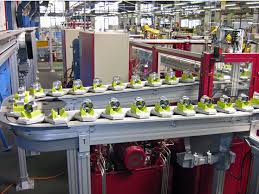FLEXIBLE MANUFACTURING SYSTEM
A flexible manufacturing system (FMS) is a configuration of
computer-controlled, semi-independent workstations where materials are
automatically handled and machine loaded. An FMS is a type of flexible
automation system that builds on the programmable automation of NC and CNC
machines. Programs and tooling setups can be changed with almost no loss of
production time for moving from production of one product to the next. An FMS
system has three key components:
1. Several computer-controlled workstations, such as CNC
machines or robots that performs a series of operations.
2. A computer-controlled transport system for moving
materials and parts from one machine to another and in and out of the system.
3. Loading and unloading stations.
Workers
bring raw materials for a part family to the loading points, where the FMS takes
over. Computer-controlled transporters deliver the materials to various
workstations where they pass through a specific sequence of operations unique
to each part. The route is determined by the central computer. The goal of
using FMS systems is to synchronize activities and maximize the system’s
utilization. Because automation makes it possible to switch tools quickly,
setup times for machines are short. This flexibility often allows one machine
to perform an operation when another is down for maintenance and avoids
bottlenecks by routing parts to another machine when one is busy.
Figure shows the layout of a typical
FMS, which produces turning and machining centers.1 Specific characteristics of
this FMS include the following:
v The computer control room (right)
houses the main computer, which controls the transporter and sequence of
operations.
v Three CNC machines, each with its own
microprocessor, control the details of the machining process. Two AGVs, which
travel around a 200-foot-long oval track, move materials on pallets to and from
the CNCs. When the AGVs’ batteries run low, the Central computer directs them
to certain spots on the track for recharging.
v Indexing tables lie between each CNC
and the track. Inbound pallets from an AGV are automatically transferred to the
right side of the table, and out-bound
Pallets
holding finished parts are transferred to the left side for pickup.
v A tool changer located behind each CNC
loads and unloads tool magazines. Each magazine holds an assortment of tools. A
machine automatically selects tools for the next specific operation. Changing
from one tool to another takes only 2 minutes.
v Two load and unload stations are
manually loaded by workers; loading takes 10 to 20 minutes.
v An automatic AS/RS (upper right)
stores finished parts. The AGV transfers parts on its pallet to an indexing
table, which then transfers them to the AS/RS. The process is reversed when
parts are needed for assembly into finished products elsewhere in the plant.
A much more popular version of flexible
automation is the flexible manufacturing
cell (FMC), which is a scaled-down version of FMS that consists of one
or a very small group of NC machines that may or may not be linked to a
materials handling mechanism. The FMC doesn’t have a materials handling system
controlled by a computer, which moves parts to the appropriate machines, as
does the more sophisticated FMS.






No comments:
Post a Comment